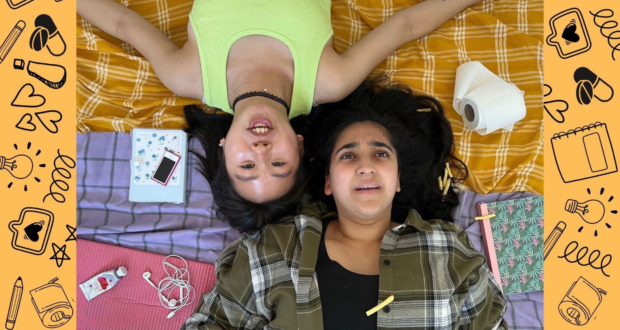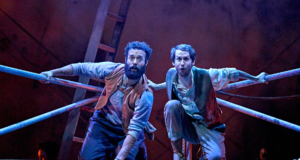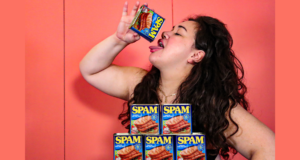Gurjot Dhaliwal and Megan Soh on Asian Girls In Therapy
Fresh from their sessions at Vault Festival, Gurjot Dhaliwal & Megan Soh’s Asian Girls In Therapy will soon be back on the couch at The Hope Theatre this August as part of Camden Fringe. The show follows Kiran and Cheon, lovers of K-pop and Bollywood, through their therapy sessions, as well as letting us into the thoughts of their personal diaries.
Whilst mental health is a subject that is being explored more and more on stage, it’s probably safe to say that it can still be something not discussed in many cultures, and so Asian Girls In Therapy certainly feels a show that could take us into more unchartered territory. To find out if so, we booked a session with Gurjot and Megan to let them tell us more.
How would you describe Asian Girls In Therapy to anyone considering coming along in August?
‘Asian Girls In Therapy’ is a Bollywood-K-pop fusion of joy, heartbreak, humour and depression. A deep-dive into the vibrant messy inner worlds of two Asian girls in their therapy journey.
What was the inspiration to approach mental health via a mixture of diary entries and therapy sessions?
Both mediums are very intimate; ones that typically we don’t get to venture into other than our own. This excited us as the therapy sessions allow an audience to be a fly on the wall of the awkwardness and rawness of ones therapy journey. The diary entries we felt complimented the therapy sessions in that it allows an audience to get to know the girls and their struggles without the defence mechanisms of therapist being present; therefore having both Kiran and Cheon at their most vulnerable state. Though separate in their own struggle, we wanted to convey that these two girls are not alone in their healing journey by having their stories take place parallel to one another.
You’re tackling what is always a tricky subject matter through some dark comedy – do you feel it is important that we always manage to laugh at ourselves no matter how dark things get?
What we wanted most was to depict mental health in its most truthful light. So whilst the girls are seen often to use humour as a defence mechanism; they also grow through their therapy journey to become more comfortable with displaying their true feelings unfiltered.
The use of dark humour was an obvious choice for both of us as writers having come from an Indian household and Malay-Chinese household respectively; due to having seen the women around us growing up often using humour in their darkest of struggles. Humour and depression were co-existing in the women we grew up around and truly they are the inspiration of this story.
It is perhaps not so much whether we should laugh at ourselves no matter how dark things get and more so the humour that is naturally present in even our darkest moments. It is often the absurdity of the situation we find ourselves in that makes us laugh albeit in a sad way; it is the light within the dark.
Is there any difference in how mental health is discussed between UK and Asian culture?
The difference is mainly the way both cultures view mental health. People in the UK are becoming more open talking about their own mental health and discussing it as a wider issue although there are still some stigmas attached. However, the Asian community can be very conservative, when it comes to such matters that are deemed personal and not something to discuss with the wider community. The sense of shame and secrecy surrounding mental health within our cultures has made it a taboo subject. There aren’t many plays, films or TV series that take on the Asian perspective on mental health and that is the gap we wanted to fill with Kiran and Cheon. Seeing our stories onstage and onscreen, especially when based on subject matters that are taboo, is vital to the community as a whole, as we feel it will embolden us to talk about our pain as we individually experience it and encourage those within the community to open a healthy dialogue about mental health for future generations and those of the diaspora.
Whilst we are becoming much more open and willing to talk about mental health, do you feel there is there still a taboo around therapy? How do you ensure that your portrayal of therapy isn’t a negative one that could put people off seeking it when it’s needed?
Our portrayal of therapy is just one in a billion ways of how we cope with our mental health within a therapy setting. Like the marvel Dr Strange, this is a multi-verse version of these two Asian girls experience and as is seen by Kiran and Cheon’s differing experience with Dr Sarah.
Having the girls constantly in and out of therapy sessions, we feel breaks the audiences relation to taboo attached with therapy as the setting itself invites the audience to take a deeper view of the two girls as people and their stories. Also, by having two, young, south Asian and south-east Asian girls in their therapy sessions within itself is a statement against the taboo; hopefully inciting an encouragement of being more open about going to therapy or thinking of doing so. After the Vaults, we were approached by many young Asian girls like ourselves who simply mentioned ‘I’ve also been to therapy’ as easily as one would say ‘I went to the gym’. This we feel is one of the aims of the piece; talking of our mental/ emotional health as openly as we would about taking care of our physical health.
There’s plenty of music in the show, how important is the music and was creating a soundtrack part of the writing process?
Music is culturally an essential aspect for both of us as writers and the Bollywood/ k-pop fusion is used as a tool to escape and de-stress for both girls. There were plenty of choices and it came down to which we felt had the best representation for the scene. When discussing a heavy topic onstage we knew it would be important to balance it with moments of light but we wanted to keep it authentic to the girls. So we thought of what they would use as an outlet and along with the music came of course dance! Asian girl joy is as vital a part of the narrative when talking about our struggles; one cannot exist without the other.
You played at the Vaults earlier this year, how has that helped develop the show for the new run?
We received many great audience responses from the Vaults show and have since done some re-writing, as well as brought a director on board to elevate our performance with higher stakes and more depth to the piece as a whole.
Is Camden Fringe another stepping stone in developing the play further? What other plans do you have for it after August?
Definitely. With this opportunity, Camden Fringe has allowed us to highlight our protagonists story to a wider audience and we hope to take this world onto screen. We have written the pilot and are submitting it to some exciting competitions and projects, having already been long listed for a couple so far.
 Everything Theatre Reviews, interviews and news for theatre lovers, London and beyond
Everything Theatre Reviews, interviews and news for theatre lovers, London and beyond




